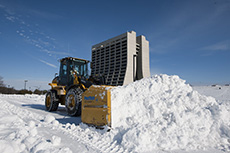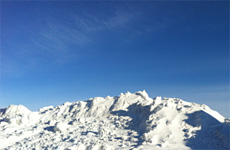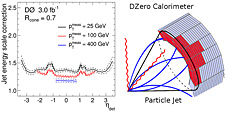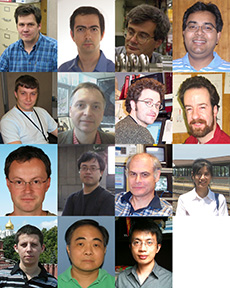|
Thursday, Jan. 9
- Breakfast: Canadian bacon, egg and cheese Texas toast
- Breakfast: corned beef hash and eggs
- Carolina pulled-pork sandwich
- Mediterranean-style ziti with asparagus
- Shepherd's pie
- Buffalo chicken tender wrap
- Grilled- or crispy-chicken Caesar salad
- Chef's choice soup
- White-chicken chili
Wilson Hall Cafe menu |
|
Friday, Jan. 10
Dinner
- Mixed greens with pears, pecan and balsamic vinaigrette
- Blue-cheese salad
- Stuffed filet of sole with crab meat
- Wilted spinach with lemon and pine nuts
- Carrot cake
Wednesday, Jan. 15
Lunch
- Fish tacos with lime crema
- Pinto salad
- Coconut flan
Chez Leon menu
Call x3524 to make your reservation.
|
|
Fermilab masters record-breaking cold
 |
Building managers and the 14-person Roads and Grounds crew ensured that Fermilab was open for business this week. The wind chill reached minus 51 degrees Fahrenheit. Photo: Reidar Hahn |
The Fermilab meteorological station registered the laboratory's lowest wind chill on record this week. On Monday, Jan. 6, at 8:50 a.m., the wind chill dropped to minus 51 degrees Fahrenheit, or minus 46 degrees Celsius. The weather station began tracking wind chill in 2003.
In the below-zero cold, Dave Shemanske's Roads and Grounds crew worked in shifts as long as 24 hours to clear the roads and parking lots for Fermilab workers and residents.
"The fact that we had the laboratory open for business Monday shows the dedication of the crew and the individual building managers," Shemanske said.
During severe weather events, the 14-person crew often begins driving dump trucks, loaders and pick-ups as early as 2 a.m. to ensure the roads are safe for morning commuters.
"The work for us really began last week," Shemanske said, referring to the snowstorm that hit the area at the beginning of the year. "Many of my guys gave up their New Year's plans to clear roads, parking lots and sidewalks. We take a great deal of pride in the site."
Fermilab's snowfall total for this winter is already over 30 inches. At extremely low temperatures, such as those seen this past week when the thermometer showed minus 17.5 F (minus 27.5 C), salt alone is not effective. In addition to plowing, the roads and grounds crew applies a mixture of beet-juice-covered salt and sand to lower the melting point and add traction to the about 36 miles of roads at Fermilab.
The cold weather created a few problems. Kent Collins, acting head of FESS, says there were "no catastrophes," but a furnace went out at a residence and a couple of sanitary pumps failed. Some cars slid off the road, but no injuries occurred.
"The crew members, building managers and other employees were all working in the bitter cold to identify and solve problems," Collins said. "FESS would not be able to manage without their assistance, and it really makes a difference."
—Amanda Solliday
|
Medical Office farewell gathering
A farewell gathering for Fermilab Medical Office staff will be held today from 1 to 3 p.m. in the Medical Office. You are invited to stop by to wish them well and enjoy refreshments with your colleagues.
|
The Alps of Batavia
 |
| On a sunny day and from the right perspective, a pile of snow on the Fermilab site looks like the French alps. Photo: Mike Albrow, PPD |
|
The power of sharing in OSG
From iSGTW, Jan. 8, 2014
As a sharing ecosystem, the Open Science Grid (OSG) doesn’t "own" any computing resources. Open Science Grid consortium members connect their resources to perform computations for their own experiments and to make available unused resources for other OSG members’ experiments. The shared compute cycles are called opportunistic.
These opportunistic cycles are helping U.S. researchers accomplish science. The OSG plays a role, to be sure, but the virtual organizations (VOs) that own the sites with computing resources are key to this sharing success. Researchers are enabling other researchers. This sharing culture enables science in new ways. The sites that provide opportunistic access are the unsung heroes in this success, and they deserve a big thank you for sharing around 80 million computing hours to enable U.S. research.
Read more
|
Dark matter near Earth peaks every March, new study suggests
From Scientific American, Jan. 6, 2014
Billions of particles of invisible "dark matter" are probably flying through your body right now, passing through the spaces between your atoms without a trace. According to conventional thinking, these particles should be somewhat less abundant during the winter and should peak around June 1. But a new study suggests this calculation is way off; the real peak is at the beginning of March.
Dark matter is thought to constitute almost 27 percent of the universe's total mass and energy, but its nature is a mystery. One of physicists' best guesses is that theorized particles called WIMPs (weakly interacting massive particles) make up this matter, but WIMPs have so far eluded detection. Whatever dark matter is, it appears to clump into large clouds called haloes that engulf galaxies, including our own Milky Way.
Read more
|
|
Calibrating jets to measure particle energies
 |
| The jet energy scale correction is used to determine the true energies of particle jets from the measured energy deposits in the DZero calorimeter. It accounts for many types of experimental effects, such as electronic noise, uninstrumented parts of the detector and interactions of particles before they reach the calorimeter. Such corrections are essential for almost all analyses performed at the DZero experiment. |
Disponible en español
The most visible legacy of the two Tevatron experiments is the still-expanding set of many hundred publications, describing world-leading measurements of the particles and forces that govern our universe. A less obvious, but still vital accomplishment is the innovation, development, and verification of the fundamental analysis techniques required to perform these measurements — techniques that have already been exported for use at the next generation of experiments at the LHC and beyond.
The DZero collaboration has made it a priority to curate and document the most important of these analysis tools to safeguard years of intellectual investment for future reference. Several DZero publications in recent months have been dedicated to the documentation of these analysis tools. Today’s article is devoted to a recent publication on the calibration of jet energies. In simple terms, this calibration enables the signals recorded in the DZero calorimeter detector to be converted into the true energies of particles produced in the initial proton-antiproton collision. It is crucial for any analysis that uses calorimeter information, including measurements of top quark and Higgs boson properties, searches for new particles and precision investigations of electroweak and quantum chromodynamic interactions.
A jet is a ubiquitous concept in collider physics: any time a quark or gluon is produced, the subsequent fragmentation and interactions generate a burst of high-energy particles, propagating through the detector in an expanding cone. Within the DZero detector, it is the calorimeter’s job to detect these particles and measure the energy that they deposit in the process. Translating the measured energy deposits back into true particle energies is a daunting task. For example, some particles will leave their energy in parts of the calorimeter that are uninstrumented; others will interact and lose energy before reaching the calorimeter. To make things worse, the effects are generally dependent on the type of particle and its properties (including the energy itself!). As an idea of the size of this effect, the measured calorimeter energy typically underestimates the particle jet energy by around 30 percent.
The jet calibration procedure is designed to account for all such effects and is determined using dedicated samples of events with well-known properties, such as back-to-back production of a photon and a single particle jet. In this case, the known energy of the photon effectively allows the jet energy to be calibrated. By using a wealth of such data-driven techniques, along with dedicated simulations, the required corrections are obtained with excellent precision at the one percent level, as testified by the many measurements that have already been published using these very techniques.
—Mark Williams
 |
| These DZero scientists made important contributions to this paper. From left to right, top row: Dmitry Bandurin, group leader (University of Virginia), Gianluca Petrillo, group leader (University of Rochester), Leo Bellantoni (Fermilab), Amitabha Das (University of Arizona). Second row: Georgy Golovanov (JINR, Dubna, Russia), Bob Hirosky (University of Virginia), Aurelio Juste (IFIA, Barcelona, Spain), Bob Kehoe (Southern Methodist University). Third row: Alexander Kupco (Institute of Physics, Prague, Czech Republic), Huanzhao Liu (Southern Methodist University), Alexander Lobodenko (Petersburg Nuclear Physics Institute, Russia), Yun-Tse Tsai (University of Rochester). Bottom row: Alexander Verkheev (JINR, Dubna, Russia), Mike Wang (Fermilab), Zhenyu Ye (UIC).
|
|
|